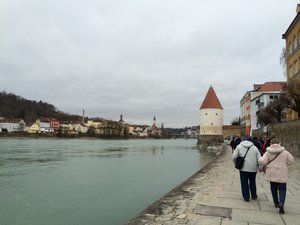Advertisement
Published: December 2nd 2014

 Old Salt Tower
Old Salt Tower
Old Salt Tower of the Inn RiverWe started our day with a tour of Passau, Germany. (I'll be quoting quite a bit from the paper our cruise line gives us each night about the following day's destination. It is really quite well written and rather than using time trying to reword what they've written, I'm copying them....giving them all the credit of course!)
Passau is a peninsula formed by the confluence of three rivers, the Inn, Ilz and the Danube. "Passau has survived endless floods because of this precarious geographical feature, along with the plagues that follow such unfortunate events, and several fires have burned the city to its foundations. After the last fire, the Bishop enlisted some of the great architects of Florence and Rome to rebuild the city and it was during that mid-17th century period that "the Venice of Bavaria" was born.
We began our tour in front of our ship at an orphanage that was built in 1727 to give a good education to the poor orphans. What the donor meant by a good education is to learn to pray well and to pray for the donor's soul that he may have a better shot at getting

 Cafe Simon
Cafe Simon
Gingerbread 101 lesson.into heaven. Ooooooookay.... We also saw the high water marks of last year's flood - the highest flood waters since 1501. It must've been devastating.
History lesson:
We continued on to learn - and see - that Passau was "a wealthy city. One of the tributaries of the Inn River is the Salzach in Austria, and from these waterways came the precious "white gold," the medieval world's most precious commodity -- salt. A city on the salt route could charge fees for docking, storage, distribution and passage and from these tolls and fees great affluence ensued. Attractive to the Catholic Church for its strategic location, both politically and militarily, the Prince Archbishops of Passau ruled over a vast territory, stretching south through present day Austria all the way to Budapest." We learned about the Old Salt Tower on the Inn riverbank where salt was unloaded from River Boats and stored.
We continued on to Passau's most famous pastry shop, Cafe Simon, where we learned about Gingerbread and tasted three different types, one made with no ginger or sugar just honey, flour and spices. Another uses molasses in place of sugar and more spices

 Cathedral of St. Stephen
Cathedral of St. Stephen
Beautiful Cathedral, but it was very difficult to get a good photo with the Market going on. and a third that I don't remember what goes into it,but I videoed it, so I can recall it from that. They were all very yummy!
We then went into the "Cathedral of St. Stephen, located on the highest point of the peninsula. The current structure, begun in the high Baroque style of 1668, is the last of a number of churches built of wood and destroyed by fire. The Cathedral is quite breathtaking, with it's heavenly white ornamentation and Italian frescos, but the most impressive feature Is the immense pipe-organ, Europe's largest with just under 18,000 pipes and 233 stops!" The only one in the world larger is in California.
After St. Stephen's we shopped and strolled the market and the city at our leisure. Of course, we got Gluhwein in the market and also Sengzelten and I still don't know exactly what it is, except that it is wonderful. On a piece of flatbread, they put smoked meat, leek, onion and cheese and then they placed it in a brick oven kind of cooker until hot.....OH MY is all I have to say about that!
Later in the afternoon, I joined

 Cathedral of St. Stephen
Cathedral of St. Stephen
The largest Pipe Organ in Europe.a group hiking up to the Vest Oberhaus, the "mighty fortress towering over the Danube and Ilz rivers, bearing silent witness to the tactile importance of the city. Built at the beginning of the 13th century (the 1200s!) by the Bishops that controlled Passau under the Holy Roman Empire, the fortress was a refuge for the clergy during times of civic unrest." I'm not sure how far up the hillside we climbed the stairs, but I was annoyed at having to stop a couple of times on the way up to, you know, take pictures! Coming down was much easier but the view was not as spectacular. It took us about an hour to hike and I'm more than happy I went!
After another spectacular meal aboard the Savor, we are off to Austria!
Advertisement
Tot: 0.138s; Tpl: 0.01s; cc: 11; qc: 50; dbt: 0.0507s; 1; m:domysql w:travelblog (10.17.0.13); sld: 1;
; mem: 1.6mb

 Old Salt Tower
Old Salt Tower 
 Cafe Simon
Cafe Simon
 Cathedral of St. Stephen
Cathedral of St. Stephen 
 Cathedral of St. Stephen
Cathedral of St. Stephen















Molly
non-member comment
Wow
Wow! Just wow! All of your pictures look amazing and looks like so much fun and so many intriguing things to discover! Y'all keep having all of the fun and be careful!